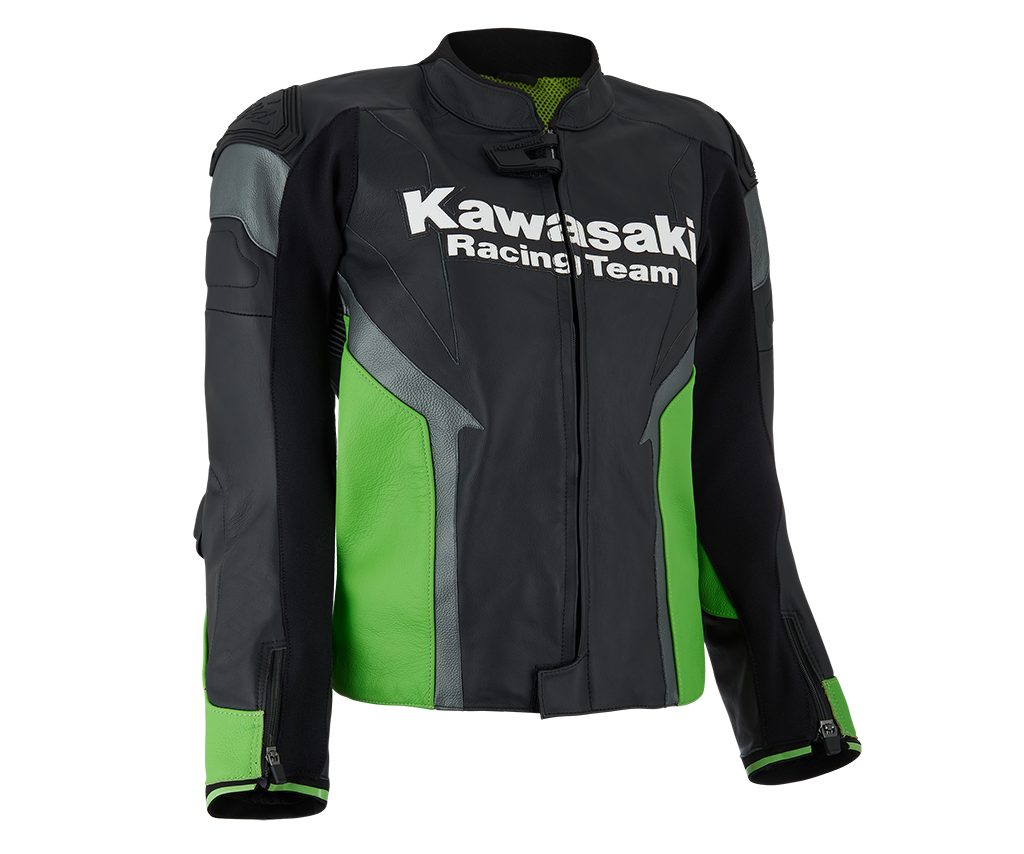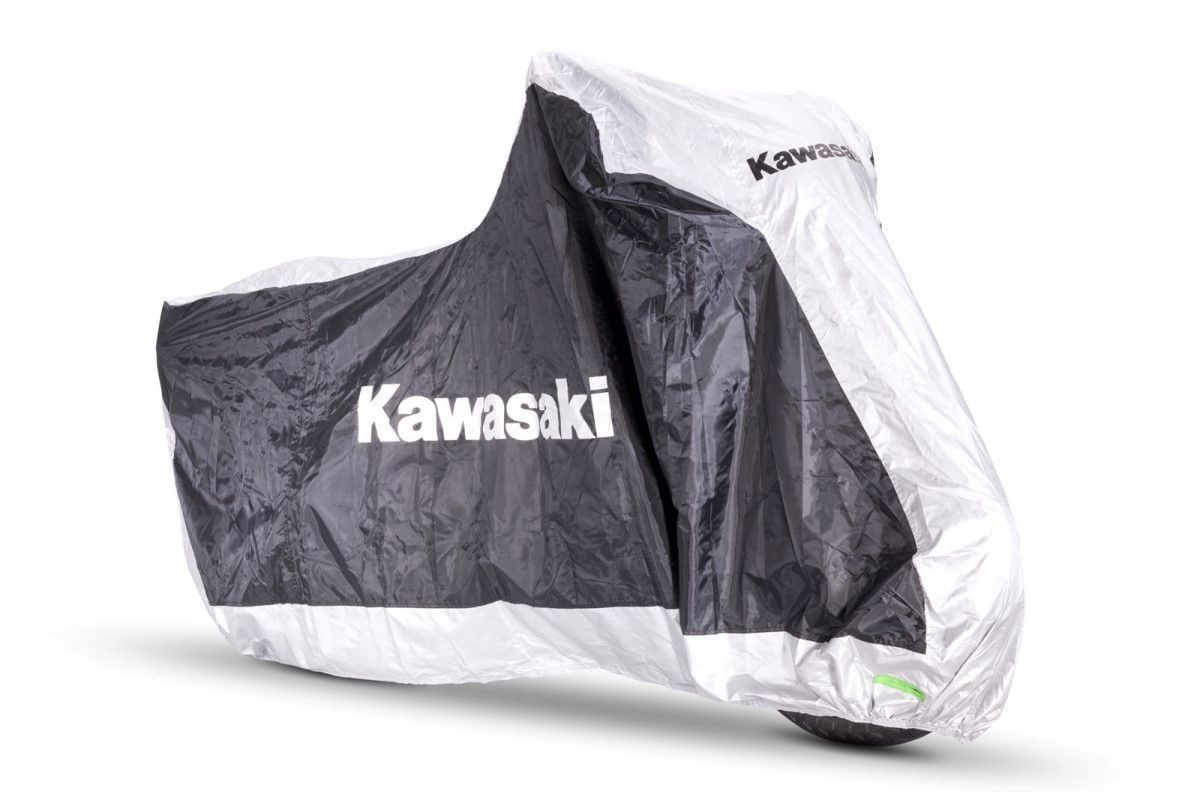
ABS
ABS (Anti-lock Brake System) ensures stable braking performance by preventing wheel lock during braking. Sudden over-application of the brakes or braking on low-grip surfaces (surfaces with a low coefficient of friction) such as wet asphalt or manhole covers may cause a motorcycle's wheel(s) to lock up and slip. ABS was developed to prevent such incidents. Kawasaki ABS systems are controlled by high precision and highly reliable programming formulated based on thorough testing of numerous riding situations. By ensuring stable braking performance, they offer rider reassurance that contributes to greater riding enjoyment. And to meet the special requirements of certain riders, specialized ABS systems are also available. For example, KIBS (Kawasaki Intelligent anti-lock Brake System) is a high-precision brake system designed specifically for Supersport models, enabling sport riding to be enjoyed by a wider range of riders. And by linking the front and rear brakes, K-ACT (Kawasaki Advanced Coactive-braking Technology) ABS provides the confidence to enjoy touring on heavyweight models. Kawasaki is continually working on the development of other advanced ABS systems.

Supercharged engine
Designed completely in-house, the immense potential of the highly compact, highly efficient supercharged engine is a testament to the technology possessed by the KHI Group. Drawing on the know-how and technology possessed by the KHI Group, Kawasaki’s supercharged engine delivers high engine output while maintaining a compact design. The key to achieving this incredible performance lies in the engine’s supercharger – a motorcycle-specific unit designed completely in-house with technology from Kawasaki’s Gas Turbine & Machinery Company, Aerospace Company and Corporate Technology Division.
One of the greatest benefits of designing the supercharger in-house and tailoring its design to match the engine’s characteristics was that engineers were able to achieve high-efficiency operation over a wide range of conditions – something that would not have been possible by simply dropping in or trying to adapt an aftermarket automotive supercharger.
The importance of high efficiency in a supercharger is that, as the air is compressed, power-robbing heat gain is minimal. And while many superchargers are able to offer high-efficiency operation in a very limited range of conditions, Kawasaki’s supercharger offers high efficiency over a wide range of pressure ratios and flow rates – meaning over a wide range of engine speeds and vehicle speeds. This wide range of efficient operation (similar to having a wide power band) easily translates to strong acceleration. The supercharger’s high efficiency and minimal heat gain also meant that an intercooler was unnecessary, greatly saving weight and space, and enabling the engine’s compact design.

Fuel Economy Assistance Mode
Fuel Economy Assistance Mode is a rider selectable mode that switches the ECU to a leaner fuel map, prioritising fuel economy to enable a longer touring range. Activating the Fuel Economy Assistance Mode switches the ECU to a leaner fuel map in which ignition timing and fuel injection prioritise fuel economy. Rather than engine response or power, this mode favours reduced fuel consumption, aiming to increase fuel economy when riding at a constant speed. When riding in areas where gasoline stands are scarce, or when cruising across the continent, being able to make the same amount of fuel last longer is a considerable benefit. Maximising the effectiveness of the Fuel Economy Assistance Mode requires a gentle use of the throttle. Nevertheless, especially when used in conjunction with the Economical Riding Indicator, this mode can contribute to significant savings in fuel costs over long distances.
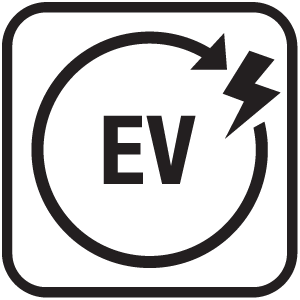
Electric Power
Kawasaki’s roadgoing EVs are powered by a compact brushless electric motor offering strong off-the-line acceleration and low-end response. Rider-selectable power levels contribute to rider confidence, while unique EV features like e-boost and WALK Mode add to the fun experience. The rider-friendly electric motor is also clean and quiet.

ERGO-FIT
ERGO-FIT is an interface system that allows a wide range of riders to feel at one with their machine. Proper fit is key for rider comfort and control. However, the ideal fit varies from rider to rider, depending on their physical dimensions and riding style. ERGO-FIT is an interface system designed to allow riders to find their ideal riding position. Various points of the chassis interface (the handlebar, footpegs and seat, etc) can be adjusted through a combination of interchangeable parts and parts with adjustable positions. This enables a wide range of riders to find a riding position that offers both comfort and control. Feeling at one with their machine, they will be able to experience how Kawasaki machines are fun and rewarding to ride. *Adjustable parts and their range of adjustability vary by model.
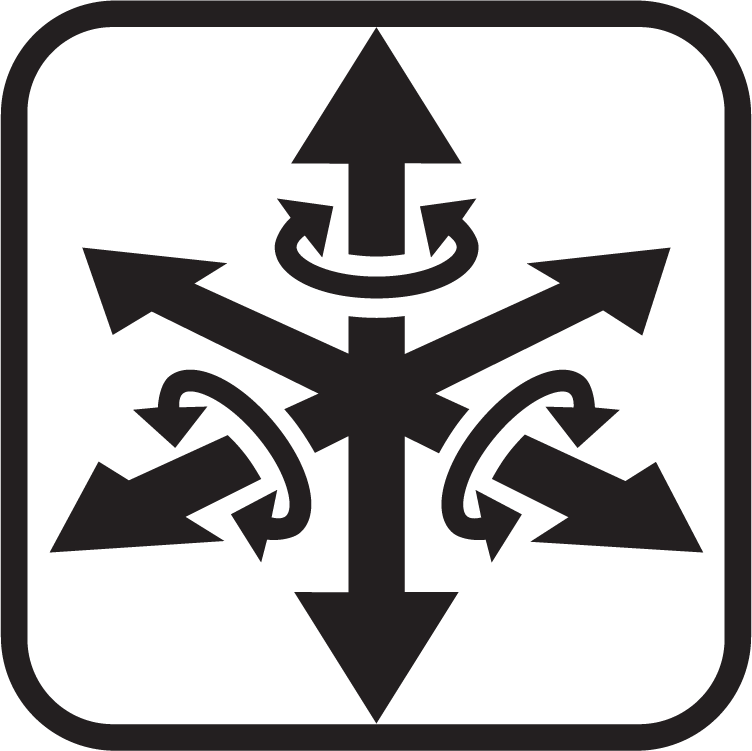
IMU
Combined with Kawasaki’s proprietary dynamic modelling program, input from the IMU (Inertial Measurement Unit) enables even more precise chassis orientation awareness, the key to bringing Kawasaki’s electronics to the next level. The strength of Kawasaki’s cutting-edge electronics has always been the highly sophisticated programming that, using minimal hardware, gives the ECU an accurate real-time picture of what the chassis is doing. Kawasaki’s proprietary dynamic modelling program makes skilful use of the magic formula tyre model as it examines changes in multiple parameters, enabling it to take into account changing road and tyre conditions. The addition of an IMU (Inertial Measurement Unit) enables inertia along 6 DOF (degrees of freedom) to be monitored. Acceleration along longitudinal, transverse and vertical axes, plus roll rate and pitch rate are measured. The yaw rate is calculated by the ECU. This additional feedback contributes to an even clearer real-time picture of chassis orientation, enabling even more precise management for control at the limit. With the addition of the IMU and the latest evolution of Kawasaki’s advanced modelling software, Kawasaki’s electronic engine and chassis management technology takes the step to the next level – changing from setting-type and reaction-type systems to feedback-type systems – to deliver even greater levels of riding excitement.

Smart regulator
The Smart Regulator is a highly efficient regulator for small-displacement models, offering increased fuel economy by minimising power drain to the generator. The electric power used for lights and fuel pumps is produced by a bike's generator. The regulator takes this power and maintains the voltage at a constant level. The Smart Regulator Kawasaki developed for small-displacement models features a built-in microprocessor, enabling control of the charging function and the headlamp. This control enables charging to be done even at idling speed, when the voltage generated is at its lowest, (provided conditions are standard and no accessories are being used), which exceeds the ability of current regulators. Additionally, once the battery is fully charged, or when the throttle is opened quickly, the smart regulator turns the charging function off, instantly reducing the electrical resistance of the generator. This enables the energy used to drive the generator to be saved – usually a big loss, especially for a small-displacement engine. By minimising power loss, the Smart Regulator contributes to increased fuel efficiency.
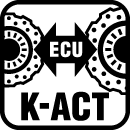
K-ACT ABS
K-ACT (Kawasaki Advanced Coactive-braking Technology) ABS is an advanced brake system that links the front and rear brakes for stable braking At its heart, K-ACT ABS is an advanced anti-lock braking system, designed to keep tyres from locking up during braking. But K-ACT ABS was designed to be used on touring models weighing in excess of 300 kg – and that is before adding a tandem rider and luggage. Complementing its standard ABS function, K-ACT ABS links the front and rear brakes. It monitors the brake force the rider is exerting at both the front and rear and takes into consideration vehicle speed to ensure highly effective braking while maintaining chassis stability. For example, let's say the rider pulls on the front brake lever. To keep the bike from pitching forward, the ABS ECU actuates the rear brake (via fluid pumps) to ensure that front-rear balance is maintained. Should the rider push the rear brake pedal, the system actuates the front brake as well to distribute the load more evenly so that the rear wheel does not lock up. Based on the vehicle speed, K-ACT decides the optimum hydraulic pressure to send to each caliper, ensuring that even with a heavy motorcycle, stable braking performance is possible.

KEBC
System Kawasaki Engine Break Control (KEBC) pozwala kierowcy wybrać w jakim stopniu chce hamować silnikiem. Gdy system jest aktywny, efekt hamowania silnikiem jest redukowany, zmniejszając interferencje podczas jazdy po torze.
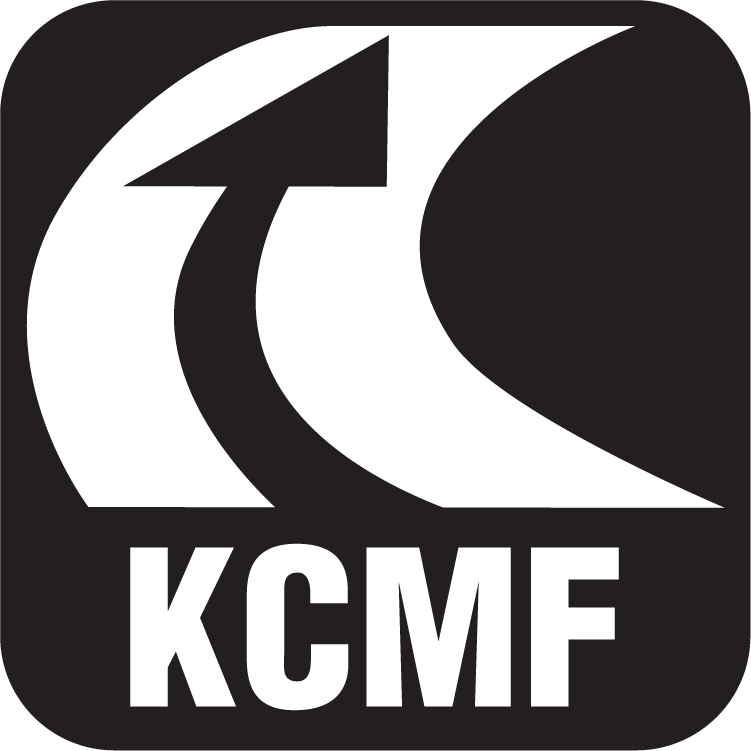
KEBC – Kawasaki Engine Brake Control
The Kawasaki Engine Brake Control system allows riders to select the amount of engine braking they prefer. When the system is activated, the engine braking effect is reduced, providing less interference when riding on the circuit.

KCMF (Kawasaki Cornering Management Function)
KCMF monitors engine and chassis parameters throughout the corner — from entry, through the apex, to corner exit — modulating brake force and engine power to facilitate smooth transition from acceleration to braking and back again, and to assist riders in tracing their intended line through the corner. KCMF oversees the following systems (where available): - KTRC (including traction, wheelie and sliding control) - KLCM - KIBS (including pitching control) - Kawasaki Engine Brake Control

KECS
KECS adapts to road and riding conditions in real time, providing the ideal amount of damping called for by electronically adjusting damping to suit vehicle speed and suspension stroke speed. Deceleration is also taken into account, which allows the system to help manage pitching that may occur during braking. Control via solenoid valve with direct actuation enables an extremely quick reaction time, making KECS ideal for sport riding applications, where natural feeling is crucial to feeling at one with the bike. Built-in stroke sensors on both the fork and rear shock provide real-time stroke speed and compression information. Input from the sensor coils to the KECS ECU is complemented by information provided by the IMU (acceleration/deceleration) and the FI ECU (vehicle speed). The KECS ECU then directs current to the solenoids to adjust damping as required by the situation. Selectable modes allow riders to choose softer or firmer base settings.

KIBS
Kawasaki developed KIBS to take into account the particular handling characteristics of supersport motorcycles, ensuring highly efficient braking with minimal intrusion during hard sport riding. It is the first mass-production brake system to link the ABS ECU (Electronic Control Unit) and engine ECU. In addition front and rear wheel speed, KIBS monitors front brake caliper hydraulic pressure, throttle position, engine speed, clutch actuation and gear position. This diverse information is analysed to determine the ideal front brake hydraulic pressure. Through precise control, the large drops in hydraulic pressure seen on standard ABS systems can be avoided. Additionally, the tendency on supersport models for the rear wheel to lift under heavy braking can be suppressed and rear brake controllability can be maintained when downshifting.
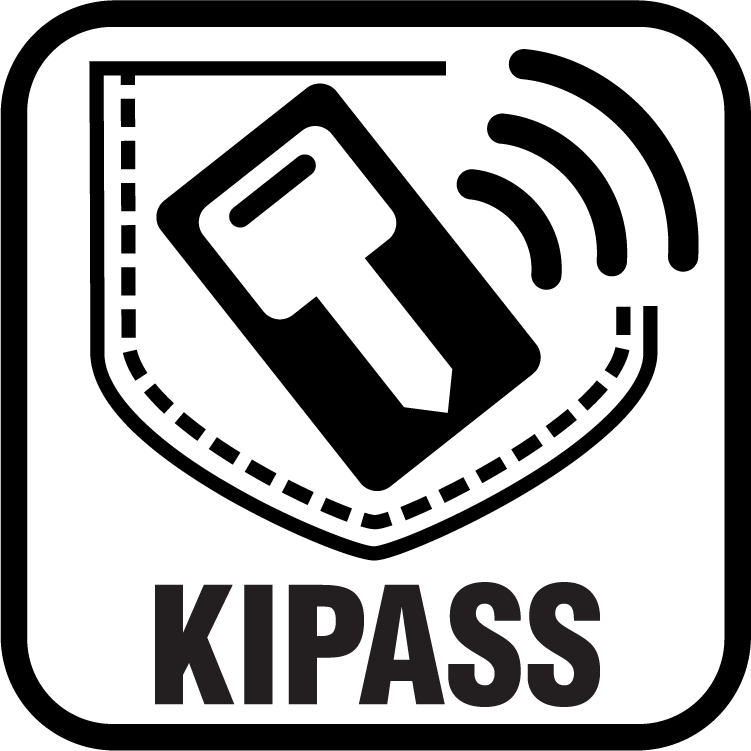
KIPASS
With the compact key fob (portable immobiliser) in a pocket, KIPASS allows riders to remotely release the bike's steering lock and main switch simply by approaching the bike. When the fob key is close to the bike, the signal it sends out is picked up and recognised by the KIPASS unit in the bike. Like immobiliser keys, each fob key has a unique signal, making this system also useful as a theft deterrent. The fob key can be recognised when in a jacket pocket, so there is no need for the rider to remove the key to operate the bike's main switch. Pannier cases and fuel tank cap are opened using the knob key inside the key cylinder. Because the knob key cannot be removed when the key fob is out of range, the keyhole is never visible, helping to prevent tampering. This system uses the encryption algorithm "MISTY" developed by MITSUBISHI ELECTRIC CORPORATION.

KLCM - Kawasaki Launch Control Mode
Designed to assist riders by optimising acceleration from a stop, KLCM electronically manages engine output to prevent wheelspin when moving off. Riders can choose from three modes, each offering a progressively greater level of intrusion. Each mode allows the rider to leave from a stop with the throttle held wide open. With the clutch lever pulled in and the system activated, engine speed is limited to a determined speed while the rider holds the throttle open. Once the rider releases the clutch lever to engage the clutch, engine speed is allowed to increase, but power is regulated to prevent wheelspin and help keep the front wheel on the ground. (In Mode 1, the least intrusive, the front wheel may lift a little.) The system disengages automatically at 150 km/h or when the rider shifts into 3rd gear.

Economical Riding Indicator
Using high-precision electronic control for engine management, Kawasaki models can achieve a high level of fuel efficiency. However, fuel consumption is greatly affected by throttle use, gear selection, and other elements under the rider's control. The Economical Riding Indicator is a function that indicates when current riding conditions are consuming a low amount of fuel. The system continuously monitors fuel consumption, regardless of vehicle speed, engine speed, throttle position and other riding conditions. When fuel consumption is low for a given speed (i.e. fuel efficiency is high), an "ECO" mark appears on the instrument panel's LCD screen. By riding so that the "ECO" mark remains on, fuel consumption can be reduced. While effective vehicle speed and engine speed may vary by model, paying attention to conditions that cause the "ECO" mark to appear can help riders improve their fuel efficiency – a handy way to increase cruising range. Further, keeping fuel consumption low also helps minimise negative impact on the environment.

KQS - Kawasaki Quick Shifter
Designed to help riders maximise their acceleration on the circuit by enabling clutchless upshifts with the throttle fully open, KQS detects that the shift lever has been actuated and sends a signal to the ECU to cut ignition so that the next gear can be engaged without having to use the clutch. On models that offer clutchless downshifts, during deceleration the system automatically controls engine speed so that the next lower gear can be selected without operating the clutch.
.png)
KTRC (1-mode)
When accelerating on a slippery surface, it is easy for rear wheel spin (i.e. when the rear wheel turns faster than the front wheel) to occur. KTRC was designed to prevent wheel spin that could otherwise cause the loss of control of the bike. Like ABS prevents wheels from locking up when braking, this Kawasaki-original traction control system prevents the rear tyre from slipping. Knowing that the system will intervene to prevent sudden wheel spin when, for example, the pavement comes to an abrupt end when touring, is a great source of reassurance for riders. KTRC uses wheel speed sensors to monitor front and rear wheel speed. When it detects wheel spin, engine power is reduced to allow rear wheel grip to be regained. KTRC also enables helps the rear wheel regain traction in situations where grip is lost temporarily, like when riding over a wet manhole cover. KTRC uses 3-way control, governing ignition timing, fuel volume and (via the sub-throttle valves) intake air volume. This 3-way control is what enables the system to be so smooth, resulting in a very natural feeling. It is technologically possible for traction control systems to recover from loss of grip due to wheel spin without the rider ever realising that they had slipped. However, KTRC lets riders know when road conditions are slippery by purposely delaying intervention for an instant. Firstly, communicating an accurate picture of current road conditions and what the bike is doing, and secondly, ensuring that systems provide support for riders – this is the philosophy that drives development of Kawasaki technology.
.png)
KTRC (2 tryby)
Kierowca ma możliwość wybrania dwóch trybów. Tryb 1 pozwala na maksymalne przyspieszenie. Tryb 2 działa bardziej zachowawczo. Ułatwia tp kierowcy bezpieczniejszą jazdę w trudnych warunkach. Istnieje możliwość wyłączenia systemu kontroli trakcji.
.png)
KTRC (3-mode)
3-mode KTRC combines the traction control technology of both 1-mode KTRC, which provides enhanced stability in slippery situations by preventing wheel slip, and S-KTRC, which helps maintain optimum traction in sport riding situations by predicting the rear wheel slip ratio during acceleration, into a single system. The convenient handle switch allows the type of traction control to be changed instantly by selecting one of the three modes, even while riding. Modes 1 and 2 maintain optimum traction during cornering, like S-KTRC. Designed with sport riding in mind, they enable sharp acceleration out of corners by maximising forward drive from the rear wheel. Modes 1 and 2 differ in the amount that they intervene. Mode 1, set for dry, good-grip road conditions, maintains the ideal slip ratio to ensure optimum traction. Mode 3 operates like 1-mode KTRC, reducing power to allow grip to be regained when rear wheel spin is detected. It is ideal when riding in slippery conditions or in the wet. Enabling riders to easily change traction control character, 3-mode KTRC is Kawasaki's most advanced engine management system.
.png)
KTRC (3-tryby, 9-poziomowy)
9-mode KTRC combines the best elements of Kawasaki’s earlier traction control systems. Riders can choose from three modes, each offering a progressively greater level of intrusion. Within each mode there are three rider-selectable levels, adding more or less intrusion (rider preferences for each mode are programmable for easy on-the-move selection from the left handle), for a total of nine possible settings. Riders may also elect to turn the system off.
The new KTRC system combines the logic and control of Kawasaki’s earlier traction control systems (S-KTRC, 1-mode KTRC) in each mode. Primary operation is similar to S-KTRC, which prioritises maximum forward acceleration using predictive-style intervention. But should excessive rear wheel speed be detected while operating in any mode, engine output is reduced to a level where grip can be regained, which provides rider reassurance by facilitating smooth riding on slippery surfaces.
Depending on the model, a Rain Mode is also included. This can be turned on and off independently of KTRC. Activating Rain Mode sets KTRC to Mode 3+, and also limits power output, torque and response. Similar to a Low Power setting, maximum engine output is reduced, and throttle response is milder.
Launch Control Mode In motocross racing, getting a good start is critical. A few tenths of a second can make the difference between getting the holeshot or not. In slippery conditions, getting the maximum drive from a motocrosser requires precise control of the both the clutch and throttle. Launch Control Mode helps riders get a good start by complementing high-level technique with engine management. Featured on a mass-production motocrosser for the first time on Kawasaki's KX450F, the system activates a separate engine map designed to get a more efficient start off the line. The system is designed to the same specifications as that used by our factory racers competing in the AMA Supercross and Motocross championships. Launch Control Mode is activated simply by pressing the button on the handlebar. The Launch Control map slightly retards ignition timing to help tame the engine's strong torque and reduce wheel spin off the start. Launch Control Mode is only active in the first two gears off the start, disengaging and returning to the standard engine map automatically once the rider shifts into 3rd gear. The system gives riders a great advantage when lining up at the gate and puts them in a better position to win.

Silver-Mirror Paint
Kawasaki’s high-quality original paint has a highly reflective, glasslike metal appearance. Its debut on the 2015 Ninja H2 and Ninja H2R marked its first use on a mass-production vehicle in either the automotive or motorcycle industries. In the shade the paint has the appearance of its base coat colour, but once in the sunlight its highly reflective surface takes on the appearance of the surrounding scenery. The stark difference in the way the paint appears in the light and the shade emphasises the sculpted shape of the bodywork on which it is applied.
The highly reflective surface is created by inducing a silver mirror reaction (a chemical reaction between a solution of silver ions and a reducing agent) that forms a layer of pure silver (Ag). This Ag layer is what creates the paint’s glasslike metal appearance. Compared to candy paints, which use aluminium flakes to generate a sparkling effect, the Ag layer appears as a uniform metallic surface. In the shade the Ag layer is translucent, allowing the base coat colour to show through. This gives the paint a deep, three-dimensional quality.
While the multiple layers of paint on typical mass-production models are done by robot painters, for this silver-mirror paint each layer – from primer to clear coat – is carefully finished by the hands of Kawasaki craftsmen to ensure a flawless, lustrous surface.
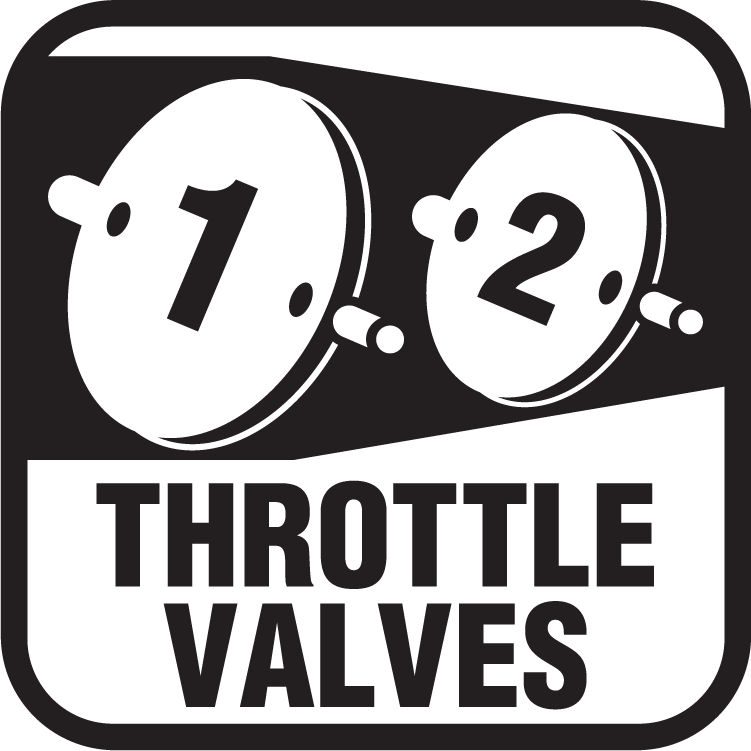
Dual Throttle Valves
Late-model sport bikes often use large-bore throttle bodies to generate high levels of power. However, with large diameter throttles, when a rider suddenly opens the throttle, the unrestricted torque response can be strong. Dual throttle valve technology was designed to tame engine response while contributing to performance. On models with dual throttle valves, there are two throttle valves per cylinder: in addition to the main valves, which are physically linked to the throttle grip and controlled by the rider, a second set of valves, opened and closed by the ECU, precisely regulates intake airflow to ensure a natural, linear response. With the air passing through the throttle bodies becoming smoother, combustion efficiency in improved and power is increased.
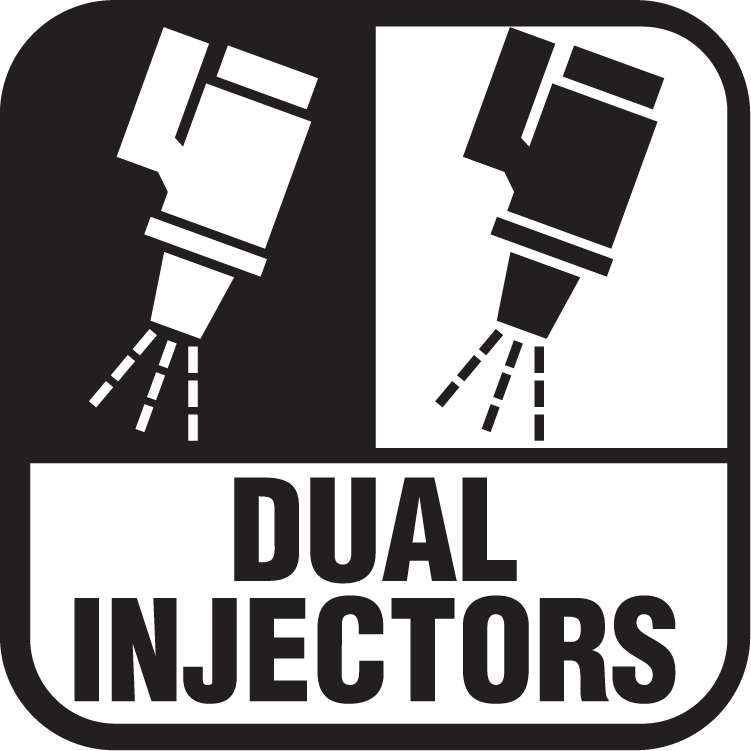
Dual injectors
Kawasaki's KX250F was the first mass-production motocrosser to feature Dual Injectors. One injector is located downstream of the throttle valve, where injectors are located on standard FI systems, and a second is located upstream of the throttle valve, close to the airbox. The two injectors split their roles: operating at different rpm ranges, they ensure both smooth, instant response at low-rpm and high peak power at high-rpm. For cases that call for low-rpm operation like instantaneous acceleration off the start and precise control when cornering, primary operation falls to the downstream injector. Because it is positioned close to the combustion chamber, sprayed fuel can be supplied to the engine quickly, resulting in sharp response. Conversely, when high power is the priority, primary operation switches to the upstream injector, which focuses on high-rpm applications. Its location farther away from the combustion chamber means that the fuel has a longer travel time. This allows more time for the fuel particles and air to mix, as well as allowing the mixture to cool and condense. This means that when more power is needed, the cylinder can be filled with a greater quantity of high-quality mixture.

Power Modes
Models equipped with multiple Power Modes offer riders an easily selectable choice of engine power delivery to suit riding conditions or preference. In addition to Full Power mode, one (Low) or two (Middle, Low) alternate mode(s) in which maximum power is limited and throttle response is milder are provided.
.png)
Power Modes (V)
Power Modes allow available power and throttle response to be selected to suit conditions. On the supersport Ninja ZX-10R, three modes are available: Full, Low (which limits power to about 60% of Full) and Middle mode, which falls between the two. More than a simply bisecting the Full and Low mode power curves, in Middle mode performance characteristics vary depending on engine speed and throttle position. At less than 50% throttle application, engine performance is essentially the same as in Low mode. However, opening the throttle past 50% allows performance up to that of Full power to be accessed. This advanced engine management system allows mild engine character for normal riding situations, with the option to tap into greater power for a quick burst of acceleration. Variable Middle Mode offers riders the ability to alter engine performance and delivery by conscious use of throttle control (either for ease of control when riding in the city, or for greater response when the rider calls for quick acceleration). This kind of technology allows supersport machines to be enjoyed in a broader range of situations.

Monocoque Frame
Kawasaki's monocoque frame is a hollow composite of aluminium parts. Originally conceived by Kawasaki engineers, it uses the engine as a fixed member so that chassis rigidity is formed not only by the frame, but the combination of the frame and engine together. Joining the engine and front and rear suspension units, the hollow box-style frame envelops the engine from above. In addition to being made from lightweight materials, its main section also acts as the air cleaner box and battery box, enabling parts to be reduced for even greater weight savings. Further, because the frame does not run beneath or alongside the engine, the chassis can be made very compact. Especially on large-displacement models, the slim chassis design of the aluminium monocoque frame contributes to ease of riding. The aluminium monocoque frame was originally developed by Kawasaki in the 1980s for their World Grand Prix works racer. In an era where steel pipe frames were the norm, the aluminium monocoque frame that debuted on the KR500 took the world by surprise. First featured on a mass-production model on the 2000 Ninja ZX-12R, this original Kawasaki technology has evolved and can be found on our large-displacement flagship models.
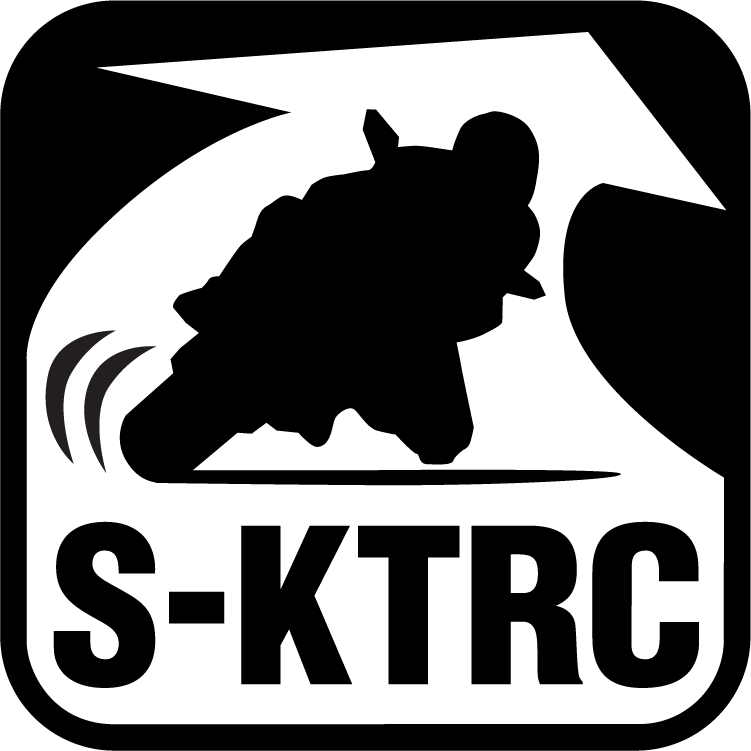
S-KTRC
S-KTRC, Kawasaki's original predictive traction control, uses the same base technology as Kawasaki’s works machines. Designed to maximise acceleration, it allows riding at the edge of traction on the track. This technology continually controls the rear wheel slip that occurs when power is applied, ensuring optimal acceleration. In general, maximum forward drive requires a certain amount of slip. To ensure the most effective transfer of power to the tarmac, S-KTRC monitors the slip ratio in real time, and governs engine power delivery to optimise rear wheel traction.
S-KTRC monitors a number of parameters, including front and rear wheel speed (slip), engine rpm, throttle position and acceleration. Conditions are confirmed every 5 milliseconds, at which time the system looks at each of the parameters as well has how much they are changing (i.e. their rate of change). This unique Kawasaki method makes it possible to make interpolations and precisely calibrate engine output to suit traction conditions. By acting before slippage exceeds the limits of traction, drops in power can be minimised, resulting in ultra-smooth operation.
Because the sophisticated software bases its dynamic analysis on the chassis’ orientation relative to the track surface (rather than relative to a horizontal plane), it is able to take into account corner camber, gradient, etc, and adapt accordingly. It also automatically adjusts for tyre wear, different tyre profiles, high-grip tyres, and numerous other factors that setting-type systems treat as fixed parameters. Models equipped with IMU incorporate chassis-orientation feedback to offer even more precise management.
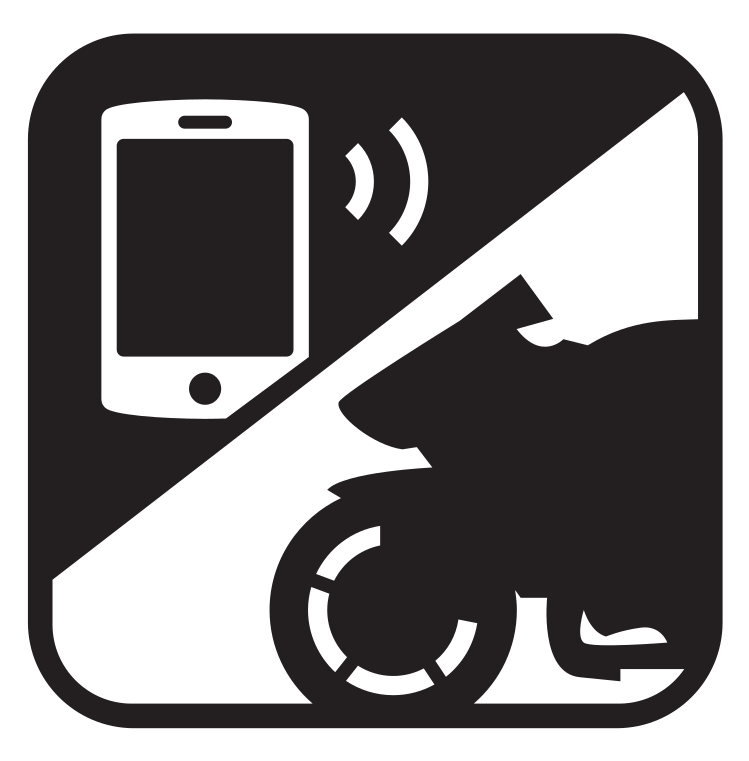
Smartphone Connectivity
Smartphone connectivity contributes to an enhanced motorcycling experience by enabling riders to connect to their motorcycle wirelessly.
Clever technology enables riders to connect to their motorcycle wirelessly. Using the smartphone application “RIDEOLOGY THE APP,” a number of instrument functions can be accessed, contributing to an enhanced motorcycling experience. Vehicle information (such as the odometer, fuel gauge, maintenance schedule, etc) can be viewed on the smartphone. Riding logs (varies by model, but may include GPS route, gear position, rpm, and other information) can be viewed on the smartphone. When connected, telephone (call, mail) notices are displayed on the instrument panel. Riders can also make changes to their motorcycle’s instrument display settings (preferred units, clock and date setting, etc) via the smartphone. And on certain models, it is even possible to check and adjust vehicle settings (such as Rider Mode, electronic rider support features, and payload settings) using the smartphone.
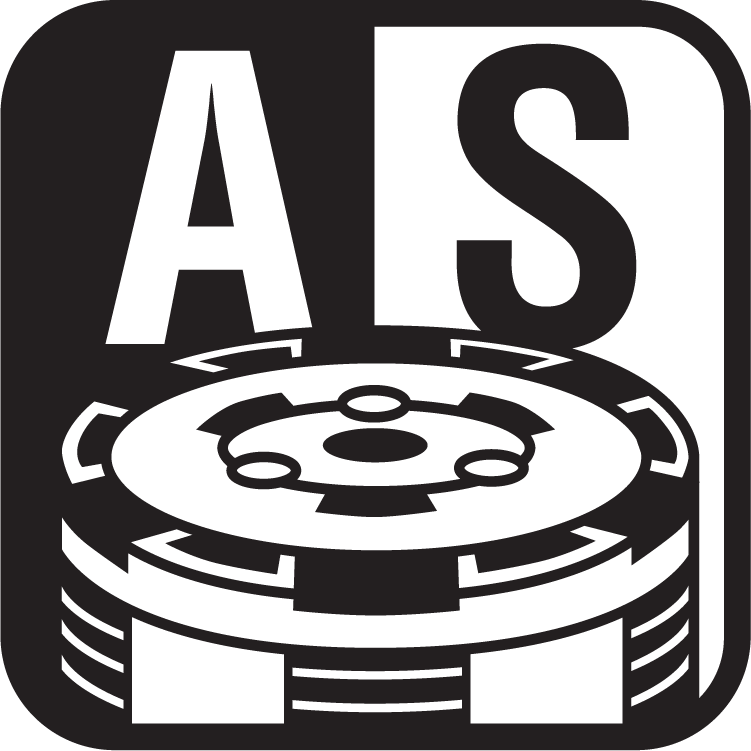
Asist & Slipper Clutch
Based on feedback from racing activities, the Assist & Slipper Clutch uses two types of cams (an assist cam and a slipper cam) to either drive the clutch hub and operating plate together or apart.
Under normal operation, the assist cam functions as a self-servo mechanism, pulling the clutch hub and operating plate together to compress the clutch plates. This allows the total clutch spring load to be reduced, resulting in a lighter clutch lever feel when operating the clutch.
When excessive engine braking occurs – as a result of quick downshifts (or an accidental downshift) – the slipper cam comes into play, forcing the clutch hub and operating plate apart. This relieves pressure on the clutch plates to reduce back-torque and helps prevent the rear tyre from hopping and skidding. This race-style function is particularly useful when sport or track riding.

System e-Boost
To prevent overheating, the e-boost operation is limited to 15 seconds. When activated, acceleration is stronger when twisting the throttle and top speed is increased. When all conditions have been met, the e-boost gauge on the instrument display will show in gray to indicate it is available. The e-boost function is activated by pressing the e-boost button at the right handle. Once activated, the gauge changes colour to purple, “e-boost” appears on the screen, and increased power is available. Once the throttle is opened past a certain degree, the 15-second countdown timer starts (indicated by the shrinking e-boost gauge). When the timer runs out, the e-boost function is disengaged. Once the bike is ready again, the e-boost function can be activated once more. e-Boost can be activated while riding or when stopped.

Cornering lights
Cornering lights provide supplemental illumination when cornering, creating a wider illuminated path in the direction the bike is heading.
Sets of three LED lights built into each side of the fairing help illuminate the road when cornering at night. Each of the three lights has a fixed direction and is activated based on lean angle. As the bike leans over, the lightscome on in order, creating a wider illuminated path in the direction the bike is heading.
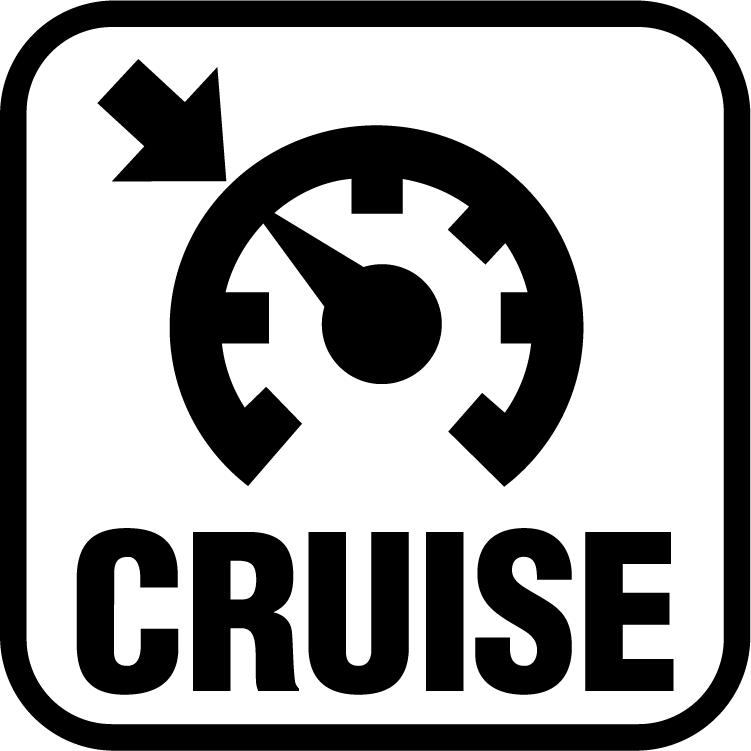
Electronic Cruise Control
Electronic Cruise Control allows a desired speed (engine rpm) to be maintained with the simple press of a button. Once activated, the rider does not have to constantly apply the throttle. This reduces stress on the right hand when travelling long distances, enabling relaxed cruising and contributing to a high level of riding comfort.

TPMS
Maintaining the correct tyre air pressure is very important as it can greatly affect a motorcycle's handling, and riding with low tyre pressure, due to a puncture, leak or other, increases the risk of a tyre bursting. Tyre air escapes naturally over time, so it is also important to check tyre pressure regularly. The Tyre Pressure Monitoring System continuously measures tyre pressure (using sensors attached to the air valves of each wheel) and displays the current pressure on the bike's instrument panel while riding. Tyre air pressure varies greatly as the tyres warm up, but the Tyre Pressure Monitoring System takes this into consideration and recalculates the pressure for 20? to avoid confusion and false warnings. When tyre air pressure is excessively low, a tyre mark appears on the display, warning the rider. On the 1400GTR / Concours 14, recommended pressure for both the front and rear wheels is 290 kPa (approximately 2.9 kgf/cm2). Should the pressure fall below 220 kPa (approximately 2.2 kgf/cm2), the warning mark will appear. Not only does this system eliminate the hassle of manually checking tyre pressure on long tours, it quickly lets the rider know of any sudden pressure loss due to, say, a punctured tyre.
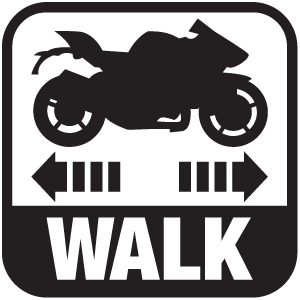
Walk mode (with reverese))
When all conditions have been met (bike stopped, throttle OFF), WALK Mode is activated by pressing and holding the Mode button. Once activated, the screen background turns red to clearly distinguish from normal operation. When engaged, opening the throttle moves the bike forward at walking speed (approximately 5 km/h). Closing the throttle past the “zero” point moves the bike in reverse. Reverse speed is approximately 3 km/h.
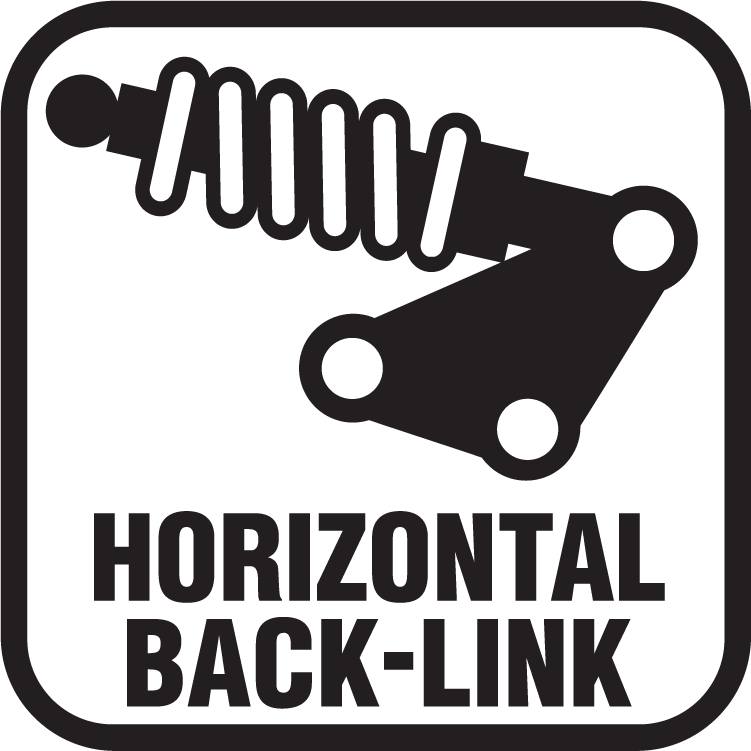
Horizontal Back-link Rear Suspension
Compared to Kawasaki's traditional Uni-Trak rear suspension, which mounts the shock unit vertically, with Horizontal Back-link rear suspension, the shock unit is almost horizontal. Kawasaki's original suspension arrangement locates the shock unit very close to the bike's centre of gravity, greatly contributing to mass centralisation. And because there is no linkage or shock unit protruding beneath the swingarm, this frees up space for a larger exhaust pre-chamber (an exhaust expansion chamber situated just upstream of the silencer). With a larger pre-chamber, silencer volume can be reduced, and heavy exhaust components can be concentrated closer to the centre of the bike, further contributing to mass centralisation. The result is greatly improved handling. Another benefit is that the shock unit is placed far away from exhaust heat. Because it is more difficult for heat from the exhaust system to adversely affect suspension oil and gas pressure, suspension performance is more stable. Horizontal Back-link rear suspension offers numerous secondary benefits like this.

Electronic Throttle Valves
Kawasaki’s fully electronic throttle actuation system enables the ECU to control the volume of both the fuel (via fuel injectors) and the air (via throttle valves) delivered to the engine. Ideal fuel injection and throttle valve position results in smooth, natural engine response and the ideal engine output. The system also makes a significant contribution to reduced emissions. Electronic throttle valves also enable more precise control of electronic engine management systems like S-KTRC and KTRC, and allow the implementation of electronic systems like KLCM, Kawasaki Engine Brake Control, and Electronic Cruise Control.

A2 Compliant with powerdown kit (EURO 4)
This version can also be adjusted to provide a maximum of 35kw to comply with A2 restrictions and the needs of motorcycle training schools. Achieved via an adjustment to the on-board ECU, only for EURO 4 models, at an authorised Kawasaki dealer, the adjustment is neither time consuming or irreversible so, when the time comes, it is possible to revert to orginal power output again via a short visit to the authorised dealer who will also create and update a record of the status.
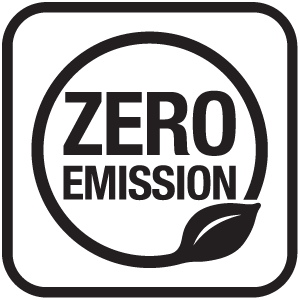
Zero Emissions
When operating exclusively using the electric motor, no emissions are created.




